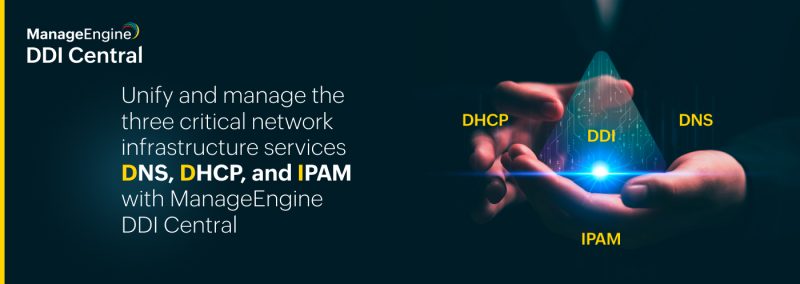
Effectively managing the dynamics of domain name lookups through the DNS is crucial for boosting the speed and security of network connections. Forward and reverse DNS lookups, the yin and yang of network connections, translate human-friendly domain names into machine-readable IP addresses and vice versa, ensuring secure connections within both public and private networks. Let’s dive deeper into how DDI Central empowers organizations to leverage forward and reverse DNS lookups effectively, enhancing network reliability, security, and performance.
Forward DNS lookups
A forward DNS lookup is the process of converting a domain name into its corresponding IP address. This is the most common type of DNS query.
What is a forward DNS lookup zone?
A forward DNS lookup zone is a DNS zone configured to facilitate mapping between domain names and IP addresses. It’s essential for everyday internet usage, enabling users to access websites through domain names.
IPv4 and IPv6:
Both address types can be mapped in a DNS zone file using address records: A records for IPv4 and AAAA records for IPv6.
Example:
To access clouddns.manageengine.com, an A record is queried, which resolves to the IPv4 address 203.0.113.45.
To access blog.zylkercorp.com, an AAAA record is queried, which resolves to the IPv6 address 2001:0db8:85a3:0000:0000:8a2e:0370:7334.
Reverse DNS lookups
Reverse DNS lookups perform the opposite function of forward lookups, translating IP addresses back into domain names. This process is crucial for various network services, including email spam filtering.
IPv4 and IPv6:
Reverse lookups use pointer records, or PTR records, in a special domain: in-addr.arpa for IPv4 and ip6.arpa for IPv6.
What is a reverse DNS lookup zone?
Reverse lookup zones in the DNS are used for resolving IP addresses back into domain names, essentially performing the opposite function of the more common forward lookup zones, which map domain names to IP addresses. This process is known as a reverse DNS lookup, or rDNS. This is particularly important for services like email, where verifying the sender’s domain against the IP address can help reduce spam.
Reverse lookup zones require careful setup to ensure accurate reverse lookups and use PTR records in designated reverse zones. Each record will correlate an IP address to a hostname, with the IP block address portion written in reverse.
While not all IP addresses have reverse DNS setups, for many applications—especially in business or enterprise environments—setting up reverse lookup zones is a crucial part of managing the network infrastructure.
Reverse zones and PTR records for IPv4 addresses
Say, for instance, in the IPv4 network block 192.168.1.0/24, there’s a user named John with the employee ID 12345. A typical forward DNS lookup for John’s hostname, using the format [hostname].[domainname].[TLD] (where TLD stands for top-level domain, like .com), would resolve to an IPv4 address as shown below:
john-12345.zylkercorp.com > 192.168.1.26
To create a reverse DNS lookup zone for John’s IP address, you would start with the network portion of your IP block, reverse it, and then append .in-addr.arpa. So, for the /24 address block, 192.168.1 is the network address and the reverse lookup zone would be:
1.168.192.in-addr.arpa
Within this reverse lookup zone, a PTR record for John’s IP address would be:
26.1.168.192.in-addr.arpa
The response for the PTR record should correctly point back to John’s hostname:
john-12345.zylkercorp.com
Reverse zones and PTR records for IPv6 addresses
For IPv6 addresses, the process is similar to IPv4, but the notation and the domain used for reverse DNS delegation are different. The domain used for IPv6 reverse DNS is .ip6.arpa. For the IPv6 address block 2001:0db8:85a3::/48, you first need to construct the reverse zone name by reversing the address block and formatting it according to the reverse lookup naming conventions for IPv6 in the DNS. For a /48 subnet, the network address involves only the first three groups of hexadecimal numbers.
-
Reverse DNS lookup zone name construction:
-
-
Start with the IPv6 prefix: 2001:0db8:85a3
-
-
-
Reverse the hexadecimal groups of the network address and separate each digit with a dot: 3.a.5.8.8.b.d.0.1.0.0.2
-
-
-
Append the standard reverse lookup suffix for IPv6: .ip6.arpa
-
-
-
So, the reverse zone name is 3.a.5.8.8.b.d.0.1.0.0.2.ip6.arpa.
-
-
Sample PTR records within this zone:
For example, let’s create PTR records for an IPv6 address in this block:
2001:0db8:85a3:0000:0000:0000:0000:abcd
To create a PTR record, we need to reverse the unique part of the address (beyond the /48 prefix), which is the last four hexadecimal digits (abcd), omitting the zeros, otherwise you’ll have to reverse the whole unique part. Following the reverse DNS lookup conventions for IPv6:
-
Reverse the unique hexadecimal digits: d, c, b, a
-
Separate each digit with a dot: d.c.b.a
-
Append the reverse zone name constructed from the /48 prefix: 3.a.5.8.8.b.d.0.1.0.0.2.ip6.arpa
Therefore, the complete PTR record for 2001:0db8:85a3::abcd would be:
d.c.b.a.3.a.5.8.8.b.d.0.1.0.0.2.ip6.arpa
The PTR record above indicates that the IP address should reverse resolve to the hostname jade-56789.zylkercorp.com, which is in the format hostname.domainname.tld referring to the top-level domain name .com. Note: Typically, one IP address maps to one hostname, although having multiple PTR records for a single IP is not prohibited by the DNS standard.
How to configure forward and reverse DNS lookup zones in DDI Central
https://
When are forward DNS lookup zones used?
Forward lookup zones are a fundamental component of the DNS, ensuring the smooth operation of the internet and private networks by making it easier for humans to access and use network resources through memorable domain names instead of exhaustive strings of IP addresses. These zones are used by DNS servers around the world to resolve client queries and direct traffic appropriately.
Forward lookup zones are utilized in a variety of situations, including:
-
Accessing websites: When you type a website address (e.g., www.clouddns.manageengine.com) into your browser, a DNS query is made in a forward lookup zone to resolve the hostname to its IP address, allowing your browser to connect to the website’s server.
-
Email services: Email clients and servers use the DNS to resolve domain names in email addresses to the IP addresses of mail servers, ensuring that emails can be correctly routed and delivered to their destination.
-
Connecting to networked services: Whether it’s cloud services, remote databases, or online APIs, clients use forward DNS lookups to find the IP addresses of the servers hosting these services, based on their hostnames.
-
Network administration and operations: In enterprise environments, forward lookup zones facilitate connections to internal servers, networked printers, file shares, and other resources by translating human-friendly domain names into IP addresses that only networked computers can understand.
-
Load balancing and redundancy: Forward lookup zones can be configured to return multiple IP addresses for a single hostname, enabling traffic to be distributed across several servers or rerouted in case of a server failure; this enhances the availability and reliability of services.
When are reverse DNS lookup zones used?
Reverse DNS lookup zones are typically used for addressing security concerns used by mail servers to verify the domain name of incoming email messages. They are also used in logging and network monitoring to resolve IP addresses to more readable domain names.
Reverse lookup zones are particularly important for:
-
Security and network troubleshooting: Reverse DNS lookup zones help in identifying and verifying the hostnames associated with incoming connections, which can be useful for security audits, logging, or tracking down network issues.
-
Email servers: Many mail servers perform a reverse DNS lookup on incoming connections to verify that the IP address of the incoming email matches the domain it claims to be from. If not authentic, these mail servers reject emails from IPs without reverse DNS lookups. This is a measure used to combat spam and phishing attacks.
-
Compliance requirements and policies: Certain enterprise network policies or compliance requirements might mandate reverse DNS lookups for auditing and to ensure that only legitimate and recognized IP addresses are allowed to connect or transact with your network or servers.
-
Human-readable logs and reports: When analyzing network traffic logs, having reverse DNS information can make the IP data more understandable by showing hostnames instead of just IP addresses.
Together, forward and reverse lookup zones ensure the DNS fulfills its mission as the phone book of the network it’s deployed on, be it a public or private network, keeping every network connection both possible and practical. Whether you’re browsing websites, sending emails, or connecting to cloud services, these DNS functionalities work tirelessly behind the scenes to maintain the connectivity and security of our online endeavors. Download a free, 30-day trial now to embrace the power of efficient DNS navigation with DDI Central, and propel your network management capabilities to new heights.

